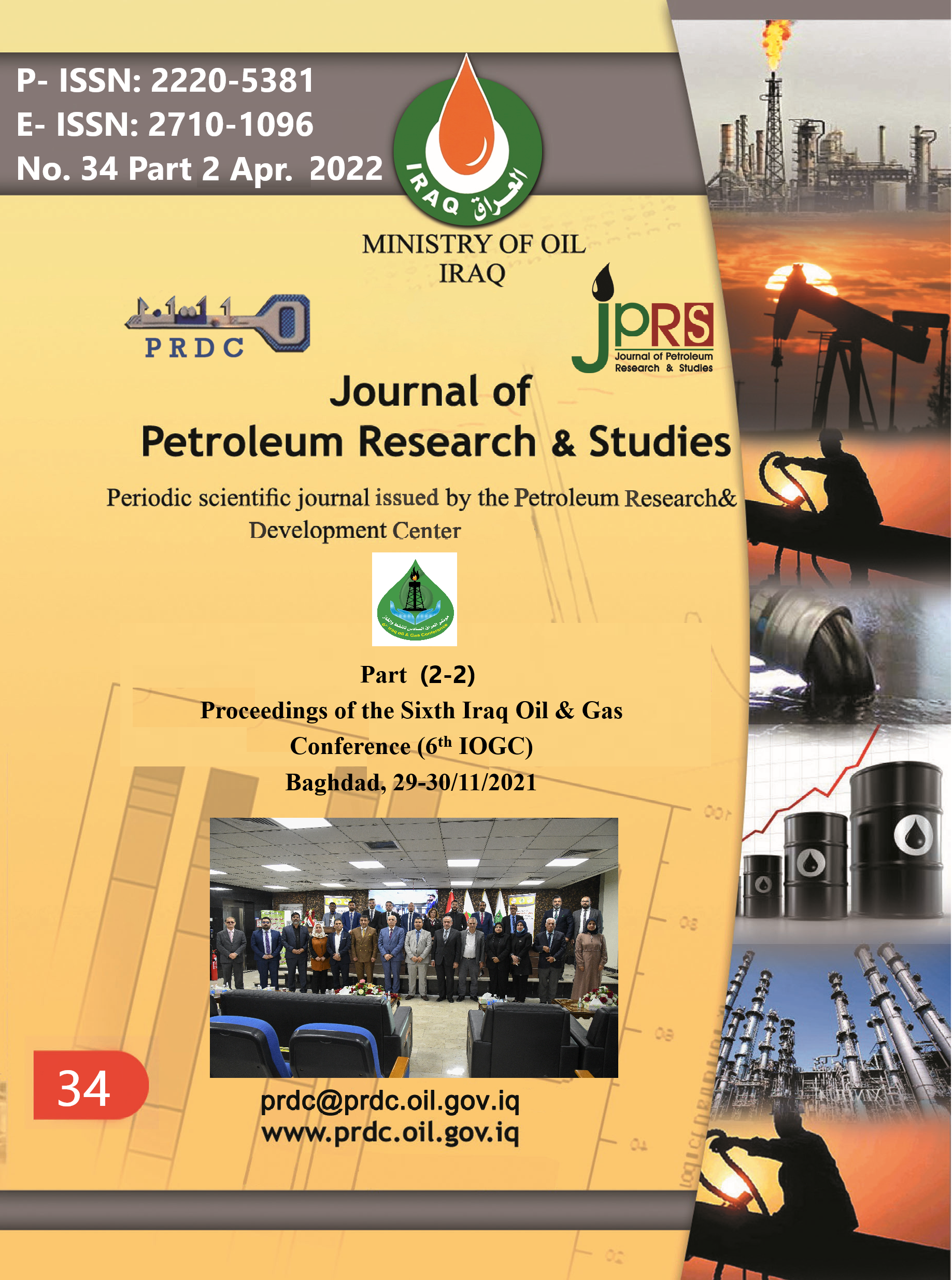Membrane Distillation Technology Using for Desalination of Associated Oil Water Production and Study Efficiency of Feed Water Operation Parameter on Air Gap Membrane Distillation Process Production
DOI:
https://doi.org/10.52716/jprs.v12i1(Suppl.).635Keywords:
Product water, Air Gap Membrane Distillation, Membrane Distillation, Desalination.Abstract
In this study; membrane distillation technology using to associated oil water production desalination by air gap membrane distillation unit to removed salt from the water after separating oil product, via PTEF commercial hydrophobic membrane distillation with 0.22 µm porous and 0.011 m contact surface area, evaluated the desalination system and operation parameter for feed water effected on process production by employment the distillation under boiling point temperature that getting commercial increments and study the energy gain by calculating the GOR of the desalination process.
The study focusing on the air gap membrane distillation desalination process by a range of temperature after primary simple sedimentation and filtration it's obtained salt rejection up to 98.9% that proves process separation efficiency. Evaluated the mean operation parameters of feed water affected on permeate water production when selected the feed temperature and flow rate with fixed coolant temperature, coolant flow rate, and air gap width to get an optimum range for feed water operation parameter to obtain optimum value to permeate water production and saving energy.
References
Alfredo Zendejas Rodriguez, Huiyao Wang, Lei Hu, Yanyan Zhang and Pei Xu. Treatment of Produced Water in the Permian Basin for Hydraulic Fracturing: Comparison of Dierent Coagulation Processes and Innovative Filter Media.water 2020.
Rand Q. Al-Khafaji1*, Abdul Halim A-K Mohammed2. Performance of Combined Electrocoagulation-Advanced Electrochemical Oxidation Used for Oil Field Produced Water Treatment. Journal of Petroleum Research & Studies (JPRS),3, 2021, pp 107 – 123.
Syarifah Nazirah Wan Ikhsan, Norhaniza Yusof , Farhana Aziz,Nurasyikin Misdan. A review of oilfield wastewater treatment using membrane filtration over conventional technology.
Kareem T. shnaihej, Lamya J. Basri, Hasan N. Mohesn. Khalid A. Sukkar. Treatment of Industrial Water by Nano Technology. Journal of Petroleum Research & Studies (JPR&S) 156. 200, pp 1-23.
Samer Adhama,⁎, Altaf Hussaina, Joel Minier-Matara, Arnold Jansona, Ramesh Sharmab. Membrane applications and opportunities for water management in the oil & gas industry. Desalination 440 (2018), pp 2–17
R. Dores, A. Hussain, M. Katebah, S. Adham, Using advanced water treatment technologies to treat produced water from the petroleum industry, SPE Int. Prod. Oper. Conf. Doha, Qatar, 2012.
M.S.H. Bader. Seawater versus produced water in oil-fields water injection operations. Desalination 208 (2007), pp 159–168.
Campos, A. L. O., Rabelo, T. S., Santos, R. O., Melo, R. F. L. V.. Cleaner production in the oil industry. The case of the water produced in the field of Carmópolis. 2005,Vol. 1, No. 03, pp. 693 – 701,
Fakhru’l-Razi Ahmaduna,b,∗, Alireza Pendashteha, Luqman Chuah Abdullaha, Dayang Radiah Awang Biaka, Sayed Siavash Madaenic, Zurina Zainal Abidina. Review of technologies for oil and gas produced water treatment. Journal of Hazardous Materials 170 (2009), pp 530–551.
Transparency Market Research, Produced Water Treatment Systems Market Will Rise to US$6.16B by 2020 at a CAGR of 6.1%; Global Industry Analysis, Size, Share, Growth, Trends and Forecast 2020, (2016), pp. 1–65 http://www.transparencymarketresearch.com/produced-water-treatment-market.html, Accessed date: 10 September 2017.
Cheryan, M.; Rajagopalan, N. Membrane processing of oil streams. Wastewater treatment and waste reduction. J. Membr. Sci. 1998, 151, 13–28.
Kasper L. Jepsen, Mads Valentin Bram, Simon Pedersen , Zhenyu Yang. Membrane Fouling for Produced Water Treatment:A Review Study From a Process Control Perspective. Water 2018, 10, 847, pp 1-28
El-Bourawi, M., Ding, Z., Ma, R. & Khayet, M. A framework for better understanding membrane distillation separation process. Journal of membrane science 285, 2006, pp 4–29.
S. Al-Obaidani, E. C.. Potentialof membrane distillation in seawater desalination: thermal efficiency, sensitivitystudy and cost estimation. J. Membr. Sci. 323, 2008 , pp. 85–98.
H. Kurokawa, T. S. (). Heat recovery characteristics of membrane distillation. Heat transfer-Japanese Research 25 , 1996, pp. 135–150.
S. Kimura, S.-I. N.-I.. Transport phenomena in membrane distillation. J. Membr. Sci. 33, 1987 , pp. 285–298.
M Khayet, T. M. Membrane distillation: principles and prencipal and applecation. Great Britian : Elsevier Pubilucation 2011.
Farzaneh Mahmoudi , Hasham Siddiqui, Mohammadebrahim Pishbin, Gholamreza Goodarzi, Saeed Dehghani, Abhijit Date, Aliakbar Akbarzadeh. Sustainable seawater desalination by permeate gap membrane distillation technology, 1st International Conference on Energy and Power, ICEP2016, 14-16 December 2016, Energy Procedia 110 ( 2017 ) , pp346 – 351.
Khalifa, A. E., & Lawal, D. U. Application of response surface and Taguchi optimization techniques to air gap membrane distillation for water desalination—A comparative study. Desalination and Water Treatment, 57(59). 2016, pp. 1-18.
Qingfeng He, Pingli Li, Hongxin Geng, Chunyao Zhang, JuanWang, Heying Chang,. Modeling and optimization of air gap membrane distillation system for desalination. Desalination 354 (2014) 68–75
Hung C. Duong, Paul Cooper, Bart Nelemans, Tzahi Y. Cath, Long D. Nghiem. Evaluating energy consumption of air gap membrane distillation for seawater desalination at pilot scale level. Separation and Purification Technology 166 (2016) 55–62
Downloads
Published
How to Cite
Issue
Section
License
Copyright (c) 2022 Safaa A. Alfaez

This work is licensed under a Creative Commons Attribution 4.0 International License.














